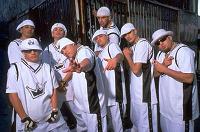"R@p"
Ivy Queen

Ivy Queen, the undisputed "Queen of Reggaeton," was born Martha
Ivelisse Pesante on March 4, 1972, in Afiasco, Puerto Rico. She
moved with her parents to New York as a child, but the family
relocated back to Afiasco while Martha was a teenager, and she
finished her public education in Puerto Rico, becoming more and
more fascinated and involved with the active underground world of
Latin hip hop. She moved to San Juan at the age of 18, where she
met rapper and producer DJ Negro, who helped her earn performing
spots at The Noise, a club catering to the emerging reggaeton scene.
DJ Negro began producing a series of CDs centered around The Noise,
and Martha -- as Ivy Queen -- made her first appearance on the
fifth installment of the CD series with a track called "Somos Raperos
Pero no Delincuentes." Ivy was growing increasingly tired of the
violent and explicit sexual lyrics rampant on the scene, and went
out on her own in 1996, releasing a debut album, En Mi Imperio, which
was quickly picked up by Sony for distribution in 1997. A second album
from Sony, The Original Rude Girl, appeared a year later in 1998,
followed by the much anticipated Diva, which was released in 2003 on
Real Music. Real appeared a year later on Universal Latino, followed
by Flashback on Univision in 2005. Steve Leggett, All Music Guide
Glittery texts by bigoo.ws
Kumbia Kings

Abraham Quintanilla III remained at the forefront of Latin pop for years
on end, primarily as a producer with a long track record, but also as the
brother of Selena, as a hit songwriter, and as a polarizing troublemaker.
His recording career began alongside that of his iconic sister, with the
release of Selena y los Dinos (1984), the first of many albums that he would
produce and co-write. As Selena's star rose, so did his. And when her star
went dark, following her tragic slaying in 1995, Quintanilla withdrew from
the limelight for a while, co-writing occasional songs for Selena followers
like Thalía and Olga Tañón. In 1999, he returned to the big time with A.B.
Quintanilla y los Kumbia Kings, a bilingual hitmaking collective that fused
traditional Mexican music (cumbia, above all) with urban American styles (hip-hop,
funk, R&B, reggae), topping it all off with a slick sheen of easily enjoyable
pop accessibility. Los Kumbia Kings, always preceded in billing -- or, later,
"presented" -- by Quintanilla, scored too many hits to list, and following their
debut album, they began hitting number one with regularity. The group unraveled,
however, following the release of their fourth album, 4 (2003), as all the leading
members of the group, including frontmen Frankie J and DJ Kane, left bitterly and
mounted recording careers of their own. In the media, this bitterness was always
coupled with references to "the business" and how they'd learned a lot in Los
Kumbia Kings. The subtext, it's safe to deduce, is that the guys weren't getting
paid their fair share by Quintanilla, who had a track record of co-writing songs
that may have not been his to begin with -- and so it has been argued to no clear
resolve. In any event, penny-pincher or not, Quintanilla proved himself to be a
savvy producer and co-writer, as no matter whom he worked with, he scored hits.
For instance, Los Kumbia Kings remained successful even after their mass regrouping,
and following another intra-group feud over money, Quintanilla enjoyed instant
success with a new group of his, the Kumbia All Starz.
Wisin Y Yandel

The popular reggaeton duo of Wisin and Yandel is from Cayey, Puerto Rico. Before
getting together to form one of the genres most successful Latin music acts, Wisin
was studying theater/acting, while Yandel worked as a barber. They fell in love with
the reggae-Panamanian Dancehall music that was eventually named reggaeton and jumped
into Puerto Rico's underground urban music scene.In reggaeton's infancy, most of the
music that was produced came in the form of compilation albums gathered together by the
DJs that were promoting the music. Wisin & Yandel followed the familiar route and in 1998
appeared on DJ Dicky's effort No Fear 3. The album was released by Fresh Productions;
they subsequently signed with that label and the following year released their debut
album Los Reyes del Nuevo Milenio.In the following years, they released three more albums,
all of which met with good success in the Latin American markets. In 2004, they also each
released a solo album: Yandel's was titled Quien Contra Mi, while Wisin gained a nickname
with his El Sobreviviente. It wasn't until 2005 with the release of Pa'l Mundo that they
caught the attention of a broader, non-Spanish speaking audience.
Tito

The popular reggaeton duo of Wisin and Yandel is from Cayey, Puerto Rico. Before getting
together to form one of the genres most successful Latin music acts, Wisin was studying
theater/acting, while Yandel worked as a barber. They fell in love with the reggae-Panamanian
Dancehall music that was eventually named reggaeton and jumped into Puerto Rico's underground
urban music scene.In reggaeton's infancy, most of the music that was produced came in the
form of compilation albums gathered together by the DJs that were promoting the music. Wisin
& Yandel followed the familiar route and in 1998 appeared on DJ Dicky's effort No Fear 3.
The album was released by Fresh Productions; they subsequently signed with that label and
the following year released their debut album Los Reyes del Nuevo Milenio.In the following
years, they released three more albums, all of which met with good success in the Latin American
markets. In 2004, they also each released a solo album: Yandel's was titled Quien Contra Mi,
while Wisin gained a nickname with his El Sobreviviente. It wasn't until 2005 with the release
of Pa'l Mundo that they caught the attention of a broader, non-Spanish speaking audience.
Click here to see more
pictures/music/
Back



